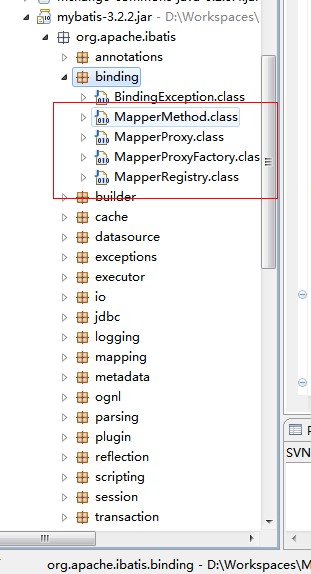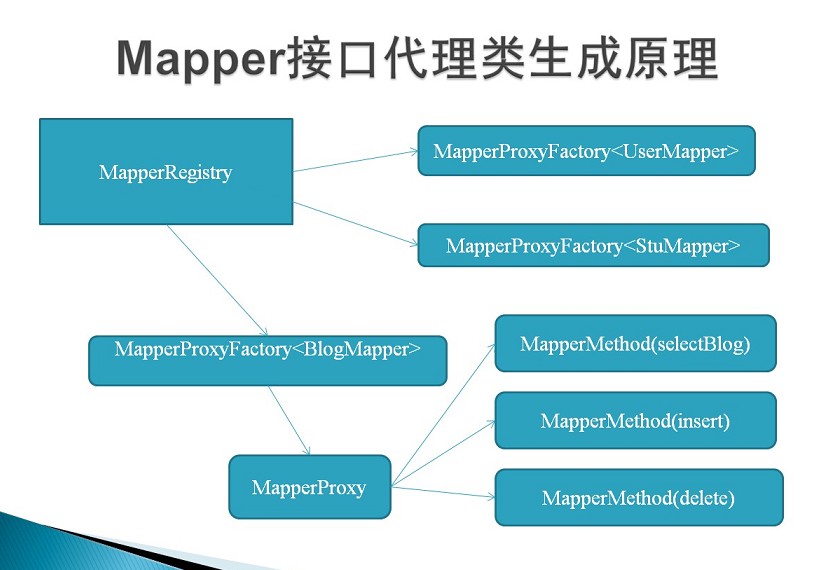我们以往使用ibatis或者mybatis 都是以这种方式调用XML当中定义的CRUD标签来执行SQL 比如这样
1. 无Mapper使用方法
<?xml version="1.0" encoding="UTF-8" ?><!DOCTYPE mapperPUBLIC "-//mybatis.org//DTD Mapper 3.0//EN""http://mybatis.org/dtd/mybatis-3-mapper.dtd"><mapper namespace="org.mybatis.example.BlogMapper"><select id="selectBlog" resultType="Blog">select * from Blog where id = #{id}</select></mapper>
SqlSession session = sqlSessionFactory.openSession();try {Blog blog = (Blog) session.selectOne("org.mybatis.example.BlogMapper.selectBlog", 101);} finally {session.close();}
这种方式有很明显的缺点就是通过字符串去调用标签定义的SQL,第一容易出错,第二是当XML当中的id修改过以后你不知道在程序当中有多少个地方使用了这个ID,需要手工查找并一一修改。在Mybatis这个版本中做了一些改进,支持这种方式调用。
**
2. 定义Mapper接口方法
定义一个接口 方法名,参数需要与XML定义保持一致。
org.mybatis.example.BlogMapper.selectBlogpublic interface BlogMapper {Blog selectBlog(int id);}
然后这么调用,这样以来当我们修改了XML的ID以后,只需要修改接口中的方法就可以了,编译器会在其他使用该接口的地方报错,很容易进行修改。当然好处还不只这些,还可以通过与Spring进行无缝集成,动态注入 等等。后面会一一讲到。
SqlSession session = sqlSessionFactory.openSession();try {BlogMapper mapper = session.getMapper(BlogMapper.class);Blog blog = mapper.selectBlog(101);} finally {session.close();}
本文的重点不是去讲解如何使用MyBatis(关于如何使用Mybatis可以参考官方API http://mybatis.github.io/mybatis-3/zh/getting-started.html),,)而是讲解MyBatis是如何通过接口对SqlSession进行动态封装的。
在上面的例子当中呢,BlogMapper是一个接口 它并没有实现类,为什么接口可以直接使用呢?
那是因为MyBbatis使用了JDK动态代理机制动态生成了代理类,那么代理类又是如何多SqlSession进行封装的呢?
带着这些疑问,让我们通过分析源代码的方式来解释这些问题。
Mybatis关于包装Mapper的代码都在org.apache.ibatis.binding 这个包下面。
其中有4个类。

上面的4个类封装了Mapper接口动态生成代理类的全部细节
MapperRegistry 类是注册Mapper接口与获取代理类实例的工具类
3. MapperRegistry
package org.apache.ibatis.binding;import org.apache.ibatis.builder.annotation.MapperAnnotationBuilder;import org.apache.ibatis.io.ResolverUtil;import org.apache.ibatis.session.Configuration;import org.apache.ibatis.session.SqlSession;import java.util.Collection;import java.util.Collections;import java.util.HashMap;import java.util.Map;import java.util.Set;//这个类通过名字就可以看出 是用来注册Mapper接口与获取生成代理类实例的工具类public class MapperRegistry {//全局配置文件对象private Configuration config;//一个HashMap Key是mapper的类型对象, Value是MapperProxyFactory对象//这个MapperProxyFactory是创建Mapper代理对象的工厂 我们一会在分析private final Map<Class<?>, MapperProxyFactory<?>> knownMappers = new HashMap<Class<?>, MapperProxyFactory<?>>();public MapperRegistry(Configuration config) {this.config = config;}//获取生成的代理对象@SuppressWarnings("unchecked")public <T> T getMapper(Class<T> type, SqlSession sqlSession) {//通过Mapper的接口类型 去Map当中查找 如果为空就抛异常final MapperProxyFactory<T> mapperProxyFactory = (MapperProxyFactory<T>) knownMappers.get(type);if (mapperProxyFactory == null)throw new BindingException("Type " + type + " is not known to the MapperRegistry.");try {//否则创建一个当前接口的代理对象 并且传入sqlSessionreturn mapperProxyFactory.newInstance(sqlSession);} catch (Exception e) {throw new BindingException("Error getting mapper instance. Cause: " + e, e);}}public <T> boolean hasMapper(Class<T> type) {return knownMappers.containsKey(type);}//注册Mapper接口public <T> void addMapper(Class<T> type) {if (type.isInterface()) {if (hasMapper(type)) {throw new BindingException("Type " + type + " is already known to the MapperRegistry.");}boolean loadCompleted = false;try {knownMappers.put(type, new MapperProxyFactory<T>(type));// It's important that the type is added before the parser is run// otherwise the binding may automatically be attempted by the// mapper parser. If the type is already known, it won't try.MapperAnnotationBuilder parser = new MapperAnnotationBuilder(config, type);parser.parse();loadCompleted = true;} finally {if (!loadCompleted) {knownMappers.remove(type);}}}}public Collection<Class<?>> getMappers() {return Collections.unmodifiableCollection(knownMappers.keySet());}ResolverUtil<Class<?>> resolverUtil = new ResolverUtil<Class<?>>();resolverUtil.find(new ResolverUtil.IsA(superType), packageName);Set<Class<? extends Class<?>>> mapperSet = resolverUtil.getClasses();for (Class<?> mapperClass : mapperSet) {addMapper(mapperClass);}}//通过包名扫描下面所有接口public void addMappers(String packageName) {addMappers(packageName, Object.class);}}
4. MapperProxyFactory
package org.apache.ibatis.binding;import java.lang.reflect.Method;import java.lang.reflect.Proxy;import java.util.Map;import java.util.concurrent.ConcurrentHashMap;import org.apache.ibatis.session.SqlSession;//这个类负责创建具体Mapper接口代理对象的工厂类public class MapperProxyFactory<T> {//具体Mapper接口的Class对象private final Class<T> mapperInterface;//该接口下面方法的缓存 key是方法对象 value是对接口中方法对象的封装private Map<Method, MapperMethod> methodCache = new ConcurrentHashMap<Method, MapperMethod>();//构造参数没啥好说的public MapperProxyFactory(Class<T> mapperInterface) {this.mapperInterface = mapperInterface;}public Class<T> getMapperInterface() {return mapperInterface;}public Map<Method, MapperMethod> getMethodCache() {return methodCache;}@SuppressWarnings("unchecked")protected T newInstance(MapperProxy<T> mapperProxy) {//创建了一个代理类并返回//关于Proxy的API 可以查看java官方的APIreturn (T) Proxy.newProxyInstance(mapperInterface.getClassLoader(), new Class[] { mapperInterface }, mapperProxy);}//在这里传入sqlSession 创建一个Mapper接口的代理类public T newInstance(SqlSession sqlSession) {//在这里创建了MapperProxy对象 这个类实现了JDK的动态代理接口 InvocationHandlerfinal MapperProxy<T> mapperProxy = new MapperProxy<T>(sqlSession, mapperInterface, methodCache);//调用上面的方法 返回一个接口的代理类return newInstance(mapperProxy);}}
5. MapperProxy
package org.apache.ibatis.binding;import java.io.Serializable;import java.lang.reflect.InvocationHandler;import java.lang.reflect.Method;import java.util.Map;import org.apache.ibatis.session.SqlSession;//实现了JDK动态代理的接口 InvocationHandler//在invoke方法中实现了代理方法调用的细节public class MapperProxy<T> implements InvocationHandler, Serializable {private static final long serialVersionUID = -6424540398559729838L;//SqlSessionprivate final SqlSession sqlSession;//接口的类型对象private final Class<T> mapperInterface;//接口中方法的缓存 有MapperProxyFactory传递过来的。private final Map<Method, MapperMethod> methodCache;//构造参数public MapperProxy(SqlSession sqlSession, Class<T> mapperInterface, Map<Method, MapperMethod> methodCache) {this.sqlSession = sqlSession;this.mapperInterface = mapperInterface;this.methodCache = methodCache;}//接口代理对象所有的方法调用 都会调用该方法public Object invoke(Object proxy, Method method, Object[] args) throws Throwable {//判断是不是基础方法 比如toString() hashCode()等,这些方法直接调用不需要处理if (Object.class.equals(method.getDeclaringClass())) {return method.invoke(this, args);}//这里进行缓存final MapperMethod mapperMethod = cachedMapperMethod(method);//调用mapperMethod.execute 核心的地方就在这个方法里,这个方法对才是真正对SqlSession进行的包装调用return mapperMethod.execute(sqlSession, args);}//缓存处理private MapperMethod cachedMapperMethod(Method method) {MapperMethod mapperMethod = methodCache.get(method);if (mapperMethod == null) {mapperMethod = new MapperMethod(mapperInterface, method, sqlSession.getConfiguration());methodCache.put(method, mapperMethod);}return mapperMethod;}}
6. MapperMethod
package org.apache.ibatis.binding;import org.apache.ibatis.annotations.MapKey;import org.apache.ibatis.annotations.Param;import org.apache.ibatis.mapping.MappedStatement;import org.apache.ibatis.mapping.SqlCommandType;import org.apache.ibatis.reflection.MetaObject;import org.apache.ibatis.session.Configuration;import org.apache.ibatis.session.ResultHandler;import org.apache.ibatis.session.RowBounds;import org.apache.ibatis.session.SqlSession;import java.lang.reflect.Array;import java.lang.reflect.Method;import java.util.*;//这个类是整个代理机制的核心类,对Sqlsession当中的操作进行了封装public class MapperMethod {//一个内部封 封装了SQL标签的类型 insert update delete selectprivate final SqlCommand command;//一个内部类 封装了方法的参数信息 返回类型信息等private final MethodSignature method;//构造参数public MapperMethod(Class<?> mapperInterface, Method method, Configuration config) {this.command = new SqlCommand(config, mapperInterface, method);this.method = new MethodSignature(config, method);}//这个方法是对SqlSession的包装调用public Object execute(SqlSession sqlSession, Object[] args) {//定义返回结果Object result;//如果是INSERT操作if (SqlCommandType.INSERT == command.getType()) {//处理参数Object param = method.convertArgsToSqlCommandParam(args);//调用sqlSession的insert方法result = rowCountResult(sqlSession.insert(command.getName(), param));//如果是UPDATE操作 同上} else if (SqlCommandType.UPDATE == command.getType()) {Object param = method.convertArgsToSqlCommandParam(args);result = rowCountResult(sqlSession.update(command.getName(), param));//如果是DELETE操作 同上} else if (SqlCommandType.DELETE == command.getType()) {Object param = method.convertArgsToSqlCommandParam(args);result = rowCountResult(sqlSession.delete(command.getName(), param));//如果是SELECT操作 那么情况会多一些 但是也都和sqlSession的查询方法一一对应} else if (SqlCommandType.SELECT == command.getType()) {//如果返回void 并且参数有resultHandler//则调用 void select(String statement, Object parameter, ResultHandler handler);方法if (method.returnsVoid() && method.hasResultHandler()) {executeWithResultHandler(sqlSession, args);result = null;//如果返回多行结果这调用 <E> List<E> selectList(String statement, Object parameter);//executeForMany这个方法调用的} else if (method.returnsMany()) {result = executeForMany(sqlSession, args);//如果返回类型是MAP 则调用executeForMap方法} else if (method.returnsMap()) {result = executeForMap(sqlSession, args);} else {//否则就是查询单个对象Object param = method.convertArgsToSqlCommandParam(args);result = sqlSession.selectOne(command.getName(), param);}} else {//如果全都不匹配 说明mapper中定义的方法不对throw new BindingException("Unknown execution method for: " + command.getName());}//如果返回值为空 并且方法返回值类型是基础类型 并且不是VOID 则抛出异常if (result == null && method.getReturnType().isPrimitive() && !method.returnsVoid()) {throw new BindingException("Mapper method '" + command.getName()+ " attempted to return null from a method with a primitive return type (" + method.getReturnType() + ").");}return result;}private Object rowCountResult(int rowCount) {final Object result;if (method.returnsVoid()) {result = null;} else if (Integer.class.equals(method.getReturnType()) || Integer.TYPE.equals(method.getReturnType())) {result = rowCount;} else if (Long.class.equals(method.getReturnType()) || Long.TYPE.equals(method.getReturnType())) {result = (long) rowCount;} else if (Boolean.class.equals(method.getReturnType()) || Boolean.TYPE.equals(method.getReturnType())) {result = (rowCount > 0);} else {throw new BindingException("Mapper method '" + command.getName() + "' has an unsupported return type: " + method.getReturnType());}return result;}private void executeWithResultHandler(SqlSession sqlSession, Object[] args) {MappedStatement ms = sqlSession.getConfiguration().getMappedStatement(command.getName());if (void.class.equals(ms.getResultMaps().get(0).getType())) {throw new BindingException("method " + command.getName()+ " needs either a @ResultMap annotation, a @ResultType annotation,"+ " or a resultType attribute in XML so a ResultHandler can be used as a parameter.");}Object param = method.convertArgsToSqlCommandParam(args);if (method.hasRowBounds()) {RowBounds rowBounds = method.extractRowBounds(args);sqlSession.select(command.getName(), param, rowBounds, method.extractResultHandler(args));} else {sqlSession.select(command.getName(), param, method.extractResultHandler(args));}}//返回多行结果 调用sqlSession.selectList方法private <E> Object executeForMany(SqlSession sqlSession, Object[] args) {List<E> result;Object param = method.convertArgsToSqlCommandParam(args);//如果参数含有rowBounds则调用分页的查询if (method.hasRowBounds()) {RowBounds rowBounds = method.extractRowBounds(args);result = sqlSession.<E>selectList(command.getName(), param, rowBounds);} else {//没有分页则调用普通查询result = sqlSession.<E>selectList(command.getName(), param);}// issue #510 Collections & arrays supportif (!method.getReturnType().isAssignableFrom(result.getClass())) {if (method.getReturnType().isArray()) {return convertToArray(result);} else {return convertToDeclaredCollection(sqlSession.getConfiguration(), result);}}return result;}private <E> Object convertToDeclaredCollection(Configuration config, List<E> list) {Object collection = config.getObjectFactory().create(method.getReturnType());MetaObject metaObject = config.newMetaObject(collection);metaObject.addAll(list);return collection;}@SuppressWarnings("unchecked")private <E> E[] convertToArray(List<E> list) {E[] array = (E[]) Array.newInstance(method.getReturnType().getComponentType(), list.size());array = list.toArray(array);return array;}private <K, V> Map<K, V> executeForMap(SqlSession sqlSession, Object[] args) {Map<K, V> result;Object param = method.convertArgsToSqlCommandParam(args);if (method.hasRowBounds()) {RowBounds rowBounds = method.extractRowBounds(args);result = sqlSession.<K, V>selectMap(command.getName(), param, method.getMapKey(), rowBounds);} else {result = sqlSession.<K, V>selectMap(command.getName(), param, method.getMapKey());}return result;}public static class ParamMap<V> extends HashMap<String, V> {private static final long serialVersionUID = -2212268410512043556L;@Overridepublic V get(Object key) {if (!super.containsKey(key)) {throw new BindingException("Parameter '" + key + "' not found. Available parameters are " + keySet());}return super.get(key);}}//一个内部类 封装了具体执行的动作public static class SqlCommand {//xml标签的idprivate final String name;//insert update delete select的具体类型private final SqlCommandType type;public SqlCommand(Configuration configuration, Class<?> mapperInterface, Method method) throws BindingException {//拿到全名 比如 org.mybatis.example.BlogMapper.selectBlogString statementName = mapperInterface.getName() + "." + method.getName();MappedStatement ms = null;//获取MappedStatement对象 这个对象封装了XML当中一个标签的所有信息 比如下面//<select id="selectBlog" resultType="Blog">//select * from Blog where id = #{id}//</select>if (configuration.hasStatement(statementName)) {ms = configuration.getMappedStatement(statementName);} else if (!mapperInterface.equals(method.getDeclaringClass().getName())) { // 这里是一个BUGString parentStatementName = method.getDeclaringClass().getName() + "." + method.getName();if (configuration.hasStatement(parentStatementName)) {ms = configuration.getMappedStatement(parentStatementName);}}//为空抛出异常if (ms == null) {throw new BindingException("Invalid bound statement (not found): " + statementName);}name = ms.getId();type = ms.getSqlCommandType();//判断SQL标签类型 未知就抛异常if (type == SqlCommandType.UNKNOWN) {throw new BindingException("Unknown execution method for: " + name);}}public String getName() {return name;}public SqlCommandType getType() {return type;}}//内部类 封装了接口当中方法的 参数类型 返回值类型 等信息public static class MethodSignature {//是否返回多调结果private final boolean returnsMany;//返回值是否是MAPprivate final boolean returnsMap;//返回值是否是VOIDprivate final boolean returnsVoid;//返回值类型private final Class<?> returnType;//mapKeyprivate final String mapKey;//resultHandler类型参数的位置private final Integer resultHandlerIndex;//rowBound类型参数的位置private final Integer rowBoundsIndex;//用来存放参数信息private final SortedMap<Integer, String> params;//是否存在命名参数private final boolean hasNamedParameters;//在这里对上面的属性进行初始化 就不一一详细说明了 具体实现细节可以看下面的代码。public MethodSignature(Configuration configuration, Method method) throws BindingException {this.returnType = method.getReturnType();this.returnsVoid = void.class.equals(this.returnType);this.returnsMany = (configuration.getObjectFactory().isCollection(this.returnType) || this.returnType.isArray());this.mapKey = getMapKey(method);this.returnsMap = (this.mapKey != null);this.hasNamedParameters = hasNamedParams(method);this.rowBoundsIndex = getUniqueParamIndex(method, RowBounds.class);this.resultHandlerIndex = getUniqueParamIndex(method, ResultHandler.class);this.params = Collections.unmodifiableSortedMap(getParams(method, this.hasNamedParameters));}public Object convertArgsToSqlCommandParam(Object[] args) {final int paramCount = params.size();if (args == null || paramCount == 0) {return null;} else if (!hasNamedParameters && paramCount == 1) {return args[params.keySet().iterator().next()];} else {final Map<String, Object> param = new ParamMap<Object>();int i = 0;for (Map.Entry<Integer, String> entry : params.entrySet()) {param.put(entry.getValue(), args[entry.getKey()]);// issue #71, add param names as param1, param2...but ensure backward compatibilityfinal String genericParamName = "param" + String.valueOf(i + 1);if (!param.containsKey(genericParamName)) {param.put(genericParamName, args[entry.getKey()]);}i++;}return param;}}public boolean hasRowBounds() {return (rowBoundsIndex != null);}public RowBounds extractRowBounds(Object[] args) {return (hasRowBounds() ? (RowBounds) args[rowBoundsIndex] : null);}public boolean hasResultHandler() {return (resultHandlerIndex != null);}public ResultHandler extractResultHandler(Object[] args) {return (hasResultHandler() ? (ResultHandler) args[resultHandlerIndex] : null);}public String getMapKey() {return mapKey;}public Class<?> getReturnType() {return returnType;}public boolean returnsMany() {return returnsMany;}public boolean returnsMap() {return returnsMap;}public boolean returnsVoid() {return returnsVoid;}private Integer getUniqueParamIndex(Method method, Class<?> paramType) {Integer index = null;final Class<?>[] argTypes = method.getParameterTypes();for (int i = 0; i < argTypes.length; i++) {if (paramType.isAssignableFrom(argTypes[i])) {if (index == null) {index = i;} else {throw new BindingException(method.getName() + " cannot have multiple " + paramType.getSimpleName() + " parameters");}}}return index;}private String getMapKey(Method method) {String mapKey = null;if (Map.class.isAssignableFrom(method.getReturnType())) {final MapKey mapKeyAnnotation = method.getAnnotation(MapKey.class);if (mapKeyAnnotation != null) {mapKey = mapKeyAnnotation.value();}}return mapKey;}private SortedMap<Integer, String> getParams(Method method, boolean hasNamedParameters) {final SortedMap<Integer, String> params = new TreeMap<Integer, String>();final Class<?>[] argTypes = method.getParameterTypes();for (int i = 0; i < argTypes.length; i++) {if (!RowBounds.class.isAssignableFrom(argTypes[i]) && !ResultHandler.class.isAssignableFrom(argTypes[i])) {String paramName = String.valueOf(params.size());if (hasNamedParameters) {paramName = getParamNameFromAnnotation(method, i, paramName);}params.put(i, paramName);}}return params;}private String getParamNameFromAnnotation(Method method, int i, String paramName) {final Object[] paramAnnos = method.getParameterAnnotations()[i];for (Object paramAnno : paramAnnos) {if (paramAnno instanceof Param) {paramName = ((Param) paramAnno).value();}}return paramName;}private boolean hasNamedParams(Method method) {boolean hasNamedParams = false;final Object[][] paramAnnos = method.getParameterAnnotations();for (Object[] paramAnno : paramAnnos) {for (Object aParamAnno : paramAnno) {if (aParamAnno instanceof Param) {hasNamedParams = true;break;}}}return hasNamedParams;}}}
通过上面的分析就很容易弄清楚Mybatis是如何利用JDK动态代理的机制生成代理类来对各种Mapper接口进行封装的了。


